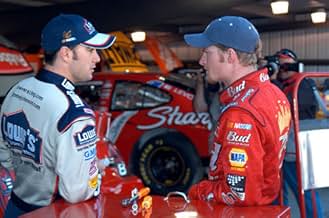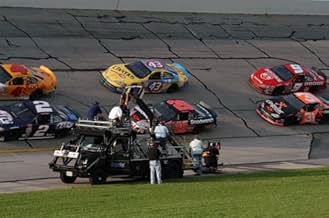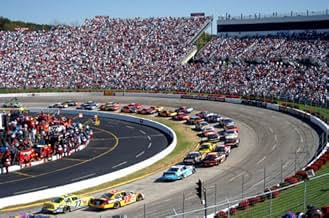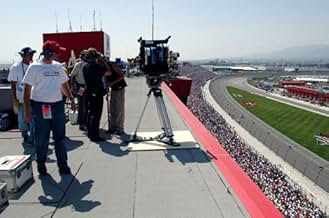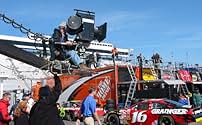Agrega una trama en tu idiomaA big-screen look into one of America's most successful entertainment industries, NASCAR racing.A big-screen look into one of America's most successful entertainment industries, NASCAR racing.A big-screen look into one of America's most successful entertainment industries, NASCAR racing.
- Dirección
- Guionista
- Elenco
- Premios
- 1 premio ganado en total
- Dirección
- Guionista
- Todo el elenco y el equipo
- Producción, taquilla y más en IMDbPro
Opiniones destacadas
We saw the NASCAR 3D IMAX movie in Nyack, NY. I was somewhat disappointed in that much of the live racing action was not in 3D, but was super-imposed as a window. The movie itself was about an hour long, not much for 10 bucks. Basically, it's a historical review of NASCAR. I'd think you really have to be into NASCAR to entirely enjoy it. However, those that haven't seen a 3D IMAX movie will be impressed. There was a positive too. With the admission ticket you could take a free "ride" on the NASCAR silicon raceway. This normally retails for $8.50. They don't advertise it though. So, if you're at the Palisades Mall, or have a virtual NASCAR facility in your area you may want to check it out.
First of all I am not a fan of Nascar, I do follow the odd Formula One race, but living in Europe, Nascar is something I may happen to see playing at five in the morning on one of the sport shows, or is a sport I prefer to play on the Playstation. As a cultural phenomenon, a thrill sport, or a symbol of national prestige (as so many American sports tend to be) it goes entirely over my head.
Now Nascar IMAX was something I was looking forward to, yes I actually thought that the promise of seeing these races in 3D would make me appreciate some of the dynamics of the sport. Alas no, or at least this is not the movie that will achieve this end. The movie is slow, with very few action scenes, doesn't look that great in 3D and is heavily dependant on dialogue. These should be basic no,no's for an IMAX movie, and yet some bright spark continues to invest heavily in such banal material.
I do long for the day when IMAX equipment will be put into the hands of a true master of cinema, I remember watching Nascar thinking, "with all this technology, all this money, the best they can do is deliver a weak documentary about racing cars?". I guess IMAX could be the next frontier of cinema, and with the way cinema is heading, this can not come any sooner. Alas, Nascar IMAX is not the one that's gonna take IMAX to the edge. So I guess the IMAX gauntlet remains unraised. Any takers??
Now Nascar IMAX was something I was looking forward to, yes I actually thought that the promise of seeing these races in 3D would make me appreciate some of the dynamics of the sport. Alas no, or at least this is not the movie that will achieve this end. The movie is slow, with very few action scenes, doesn't look that great in 3D and is heavily dependant on dialogue. These should be basic no,no's for an IMAX movie, and yet some bright spark continues to invest heavily in such banal material.
I do long for the day when IMAX equipment will be put into the hands of a true master of cinema, I remember watching Nascar thinking, "with all this technology, all this money, the best they can do is deliver a weak documentary about racing cars?". I guess IMAX could be the next frontier of cinema, and with the way cinema is heading, this can not come any sooner. Alas, Nascar IMAX is not the one that's gonna take IMAX to the edge. So I guess the IMAX gauntlet remains unraised. Any takers??
VVVRRRRRrrroooommm! The thunderous sounds at a typical NASCAR race should be unforgettable for anybody that has seen a race on TV or live at the stadium.
The excitement of watching cars drive around at almost 200 mph is lost on some, but for some people it's become almost a religion.
NASCAR, an acronym for National Association of Stock Car Auto Racing, is the subject of the latest IMAX phenomenon, "NASCAR 3D: The IMAX Experience." However, the film seems to be made primarily for educating the general public.
Not that that's a bad thing. The film deals with all possible aspects of NASCAR racing, so even NASCAR enthusiasts might learn something. Director Simon Wincer, the man that brought us the "Lonesome Dove" miniseries, brings us a film that makes us almost all of us care about the sport, NASCAR fan or not.
The script, written by Sports Illustrated NASCAR correspondent Mark Bechtel, is typical documentary fare, with interviews, stock footage, and a lot of factual information.
The first half of the movie deals largely with the history of NASCAR. The movie opens with a dramatized chase through the North Carolina wilderness, thus setting up the evolution of the sport that would eventually become NASCAR.
Following the discussion of the 1947 conference that laid the foundations of NASCAR, the film goes on to talk about some of the (relatively) early NASCAR greats: Junior Johnson, Lee Petty, Richard Petty, Kyle Petty, Darrell Waltrip, and of course, Dale Earnhardt.
Yes, they do have footage from the 2001 race that killed NASCAR's greatest star. Though they don't actually show the crash, they do make reference to it. Anybody watching the film with a more-than-mild interest in NASCAR had better expect an emotional reaction. The crash serves as a bridge linking the first half to the second half: How NASCAR Works.
This film goes through everything you can think of, from the engineers in garages building car frames and engines to the pit crews training 38 out of the 52 weeks a year.
The film discusses the importance of teams, how a typical race works, and even what the fans are like. People that know nothing about NASCAR would learn a lot from this film.
Okay, so there¡¦s nothing really special about the script, but that's not where this film excels. "NASCAR 3D" makes the most of the IMAX technology, and the filmmakers know it. "NASCAR 3D" is one of the few IMAX movies that have the IMAX specs right on the poster.
The film's remarkable cinematography puts you right into the action. Cars zoom past camera placed on the track. Cameras inside the car allow you to see what the driver sees. Aerial shots show exactly what a mob of 120,000 people looks like. The list goes on.
The editing job is top notch. Rapid editing gives viewers the impression that there is a lot more going on in the race than cars racing around a racecourse. An impressive sequence where stock footage of a crash is repeated all over the screen can best be described as awe-inspiring.
The IMAX sound technology is put to good use. The sound of roaring engines is strong enough to rumble the seats. Good luck in finding that same effect in movie theaters.
However, there is a surprisingly large amount of relatively quiet moments present in the film, so the rumble effect isn't used that often. This isn't actually that bad. After all, there is probably a limit to how much a person can stand to be vibrated.
The technological strengths of this movie make up for the blandness of the screenplay, making "NASCAR 3D" one of those rare documentaries that can keep viewers interested the whole way through.
If you're already a NASCAR fan, then "NASCAR 3D" is probably near the top on your must-see list. Well, I'm not so sure about what everybody had expected, but I suppose it's safe to say that it lives up to everybody expectations. If you're not a NASCAR fan, then "NASCAR 3D" is still a worthy piece of entertainment.
So "NASCAR 3D" is must-see material. The problem is finding a theater that plays it, as there are only 75 IMAX theaters in North America carrying "NASCAR 3D".
The excitement of watching cars drive around at almost 200 mph is lost on some, but for some people it's become almost a religion.
NASCAR, an acronym for National Association of Stock Car Auto Racing, is the subject of the latest IMAX phenomenon, "NASCAR 3D: The IMAX Experience." However, the film seems to be made primarily for educating the general public.
Not that that's a bad thing. The film deals with all possible aspects of NASCAR racing, so even NASCAR enthusiasts might learn something. Director Simon Wincer, the man that brought us the "Lonesome Dove" miniseries, brings us a film that makes us almost all of us care about the sport, NASCAR fan or not.
The script, written by Sports Illustrated NASCAR correspondent Mark Bechtel, is typical documentary fare, with interviews, stock footage, and a lot of factual information.
The first half of the movie deals largely with the history of NASCAR. The movie opens with a dramatized chase through the North Carolina wilderness, thus setting up the evolution of the sport that would eventually become NASCAR.
Following the discussion of the 1947 conference that laid the foundations of NASCAR, the film goes on to talk about some of the (relatively) early NASCAR greats: Junior Johnson, Lee Petty, Richard Petty, Kyle Petty, Darrell Waltrip, and of course, Dale Earnhardt.
Yes, they do have footage from the 2001 race that killed NASCAR's greatest star. Though they don't actually show the crash, they do make reference to it. Anybody watching the film with a more-than-mild interest in NASCAR had better expect an emotional reaction. The crash serves as a bridge linking the first half to the second half: How NASCAR Works.
This film goes through everything you can think of, from the engineers in garages building car frames and engines to the pit crews training 38 out of the 52 weeks a year.
The film discusses the importance of teams, how a typical race works, and even what the fans are like. People that know nothing about NASCAR would learn a lot from this film.
Okay, so there¡¦s nothing really special about the script, but that's not where this film excels. "NASCAR 3D" makes the most of the IMAX technology, and the filmmakers know it. "NASCAR 3D" is one of the few IMAX movies that have the IMAX specs right on the poster.
The film's remarkable cinematography puts you right into the action. Cars zoom past camera placed on the track. Cameras inside the car allow you to see what the driver sees. Aerial shots show exactly what a mob of 120,000 people looks like. The list goes on.
The editing job is top notch. Rapid editing gives viewers the impression that there is a lot more going on in the race than cars racing around a racecourse. An impressive sequence where stock footage of a crash is repeated all over the screen can best be described as awe-inspiring.
The IMAX sound technology is put to good use. The sound of roaring engines is strong enough to rumble the seats. Good luck in finding that same effect in movie theaters.
However, there is a surprisingly large amount of relatively quiet moments present in the film, so the rumble effect isn't used that often. This isn't actually that bad. After all, there is probably a limit to how much a person can stand to be vibrated.
The technological strengths of this movie make up for the blandness of the screenplay, making "NASCAR 3D" one of those rare documentaries that can keep viewers interested the whole way through.
If you're already a NASCAR fan, then "NASCAR 3D" is probably near the top on your must-see list. Well, I'm not so sure about what everybody had expected, but I suppose it's safe to say that it lives up to everybody expectations. If you're not a NASCAR fan, then "NASCAR 3D" is still a worthy piece of entertainment.
So "NASCAR 3D" is must-see material. The problem is finding a theater that plays it, as there are only 75 IMAX theaters in North America carrying "NASCAR 3D".
There would be no point in denying that "NASCAR: The IMAX Experience" loses a little something in its transference to the small screen. However, it's still an eye-popping documentary for both die-hard racing fans and those viewers who know little or nothing about the sport - although the hardcore aficionados might wish there had been a little less talk on the soundtrack and a little more action on the racetrack to make the experience a more compelling and complete one.
This comes as a bit of a surprise, especially considering the fact that the film was originally shot in the 3-D IMAX format. One might reasonably expect that the movie would be little more than a succession of speeding cars and hurtling objects aimed directly at the stunned eyes of the audience. Not so, for the movie actually spends far more time on the nuts-and-bolts, behind-the-scenes aspects of NASCAR than on the racing itself. The film provides a brief background on the organization's less-than-savory moonshine roots, then proceeds to fill us in on various aspects of the sport itself, including the construction, specifications and testing of the cars, the training of the pit crews, the loyalty of the fans, etc. It also takes time out to honor the memory of the late racing great Dale Earnhardt, although due to the film's rather meager 49 minute running time, the tribute, like virtually everything else in the movie, comes across as a little more halfhearted and perfunctory than, perhaps, in all good conscience, it should.
To get most of the racing shots, director Simon Wincer strapped his camera crew into vehicles of their own in order to provide audiences with an experience as close to the real thing as possible. The majority of these sequences come in the last ten minutes or so of the film. As with all IMAX productions, the clarity and beauty of the picture is, indeed, a wonder to behold, with the colors literally leaping off the screen in many-hued splendor. Even without 3-D glasses and a two-story sized screen, this is a great visual experience. Now if they could have just shown a little more racing
This comes as a bit of a surprise, especially considering the fact that the film was originally shot in the 3-D IMAX format. One might reasonably expect that the movie would be little more than a succession of speeding cars and hurtling objects aimed directly at the stunned eyes of the audience. Not so, for the movie actually spends far more time on the nuts-and-bolts, behind-the-scenes aspects of NASCAR than on the racing itself. The film provides a brief background on the organization's less-than-savory moonshine roots, then proceeds to fill us in on various aspects of the sport itself, including the construction, specifications and testing of the cars, the training of the pit crews, the loyalty of the fans, etc. It also takes time out to honor the memory of the late racing great Dale Earnhardt, although due to the film's rather meager 49 minute running time, the tribute, like virtually everything else in the movie, comes across as a little more halfhearted and perfunctory than, perhaps, in all good conscience, it should.
To get most of the racing shots, director Simon Wincer strapped his camera crew into vehicles of their own in order to provide audiences with an experience as close to the real thing as possible. The majority of these sequences come in the last ten minutes or so of the film. As with all IMAX productions, the clarity and beauty of the picture is, indeed, a wonder to behold, with the colors literally leaping off the screen in many-hued splendor. Even without 3-D glasses and a two-story sized screen, this is a great visual experience. Now if they could have just shown a little more racing
As a die hard NASCAR fan, this movie was unbelievable! The images look so crystal clear, you could almost feel the the texture of the asphalt as you ride along. Great 3D effect, though towards the end I had a slight headache due to eye strain. The sound was the most authentic reproduction of a NASCAR race I've ever heard. The engines roar as loud and beefy as being at the track. Certainly a must see. Even the non-NASCAR fans will enjoy it and perhaps become interested in the greatest sport in the world. Only one thing that bothered me about the film was the fact that there are certain things that you wanted to see in focus... that weren't (hence the eye strain headache). If you can get a seat in the back of the theater...perhaps the eye strain would be less. Other than that... it's the best IMAX movie out there now. A must see, and I'm buying a copy when it hits the shelves on DVD. Not just 2 thumbs up... all ten digits up!
¿Sabías que…?
- Versiones alternativasIMAX theaters that were not capable of showing 3D movies showed "NASCAR: The IMAX Experience", an alternate 2D version.
- Bandas sonorasJesus Built My Hotrod
Written by Michael Balch, Paul Barker, Gibby Haynes, Al Jourgensen (as Alien Jourgensen) and Bill Rieflin
Performed by Ministry
Courtesy of Sire Records
By Arrangement with Warner Strategic Marketing
Selecciones populares
Inicia sesión para calificar y agrega a la lista de videos para obtener recomendaciones personalizadas
Detalles
- Fecha de lanzamiento
- Países de origen
- Sitio oficial
- Idioma
- También se conoce como
- NASCAR: The IMAX Experience
- Locaciones de filmación
- Productoras
- Ver más créditos de la compañía en IMDbPro
Taquilla
- Total en EE. UU. y Canadá
- USD 21,583,831
- Fin de semana de estreno en EE. UU. y Canadá
- USD 1,452,639
- 14 mar 2004
- Total a nivel mundial
- USD 22,248,831
- Tiempo de ejecución48 minutos
- Color
- Mezcla de sonido
- Relación de aspecto
- 1.44 : 1
Contribuir a esta página
Sugiere una edición o agrega el contenido que falta

Principales brechas de datos
By what name was NASCAR 3D: The IMAX Experience (2004) officially released in Canada in English?
Responda



